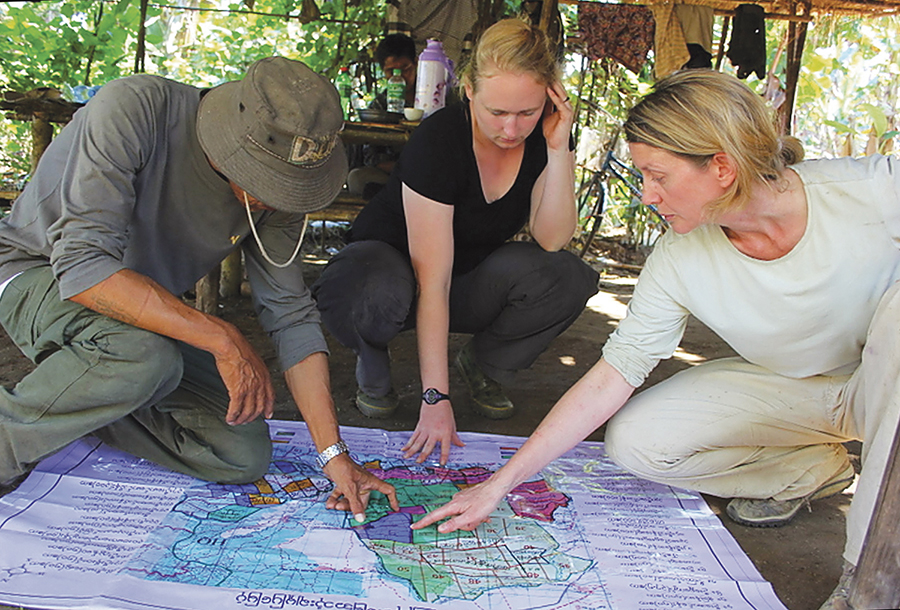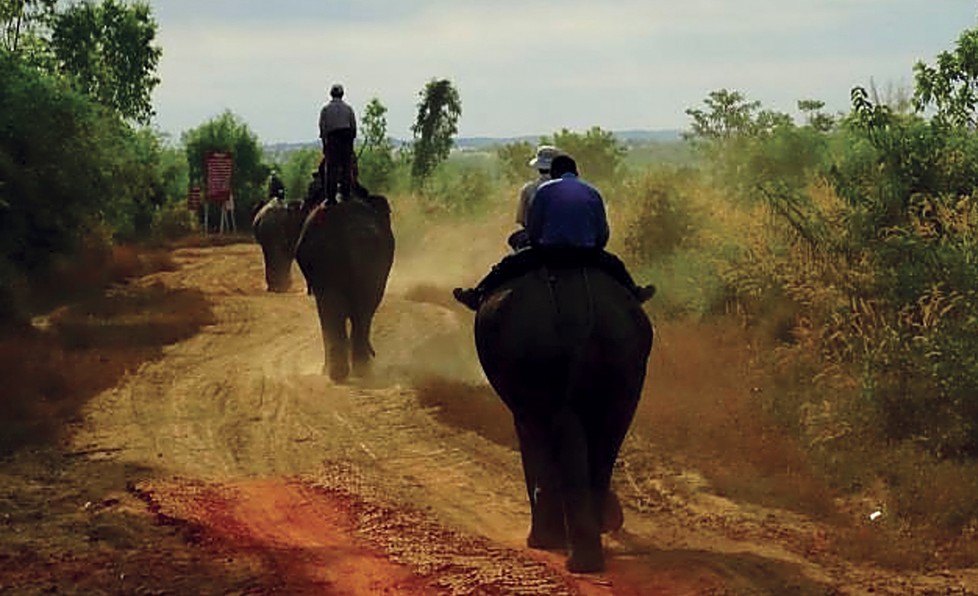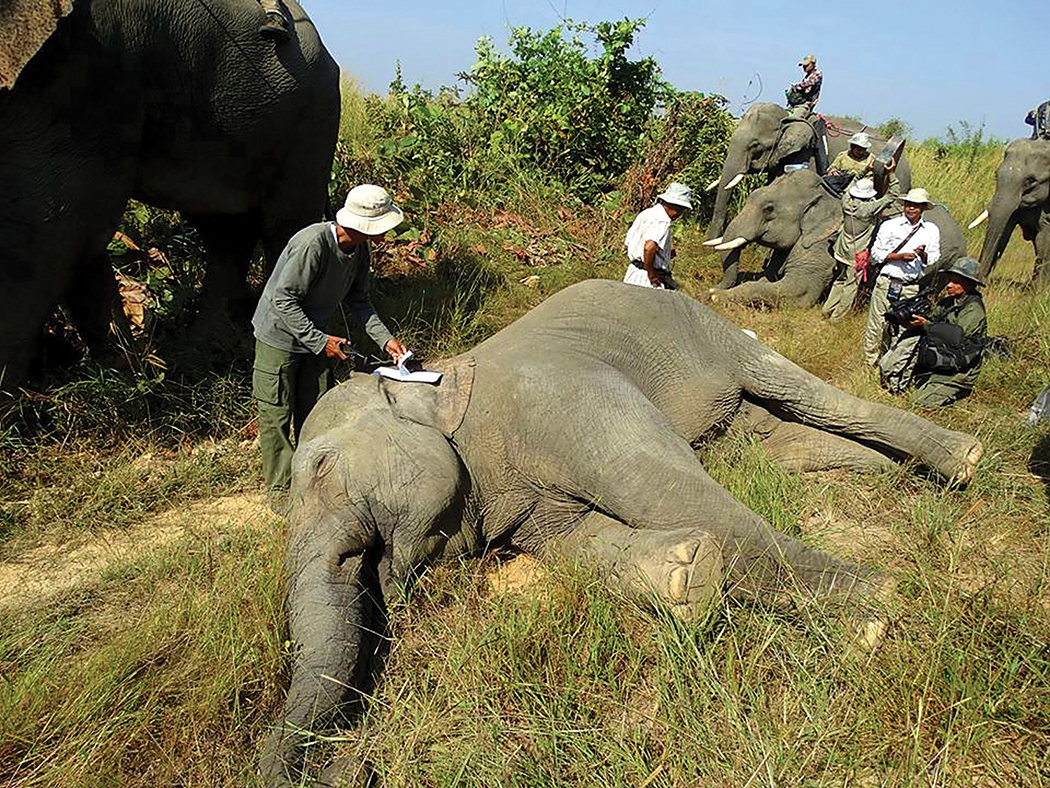Making peace with the giants
by Jemma Everyhope-Roser
When Christie Sampson tracks a herd across Myanmar, the fabled vampire elephant is the least of her worries.
“The first words I usually learn in a country are ‘hello,’ ‘thank you,’ and ‘run,’” says Christie Sampson, a Ph.D. student in biological sciences who studies human-elephant conflict, most recently in Myanmar. “People think this is a glamorous project. Riding on elephants all day. But a lot of the time, like most biology projects, you’re out looking for scat, or dung.”
Once, in Sri Lanka, Sampson used dung to do population estimates by walking kilometer-long transects. “You walk in a straight line and you look on each side, and every time you see a dung pile, you measure it and mark it down.” Sampson, intently focused on staying on course and accurately noting each dung pile, became oblivious to her wider surroundings. Until, that is, a lookout jogging alongside her shouted, “Run!”
Sometimes, a nervous or irritable elephant will trumpet. Or stomp and stir up dust. Or rip out grass and throw it. Sometimes. But not always. Sometimes, elephants charge without warning.
“If they feel aggressive, if they feel scared, they’ll charge you,” Sampson says. “I’m not a very good tree climber. So I usually end up hiding under bushes.”
Then one of the team uses fire crackers to scare the elephant off.
In North America, we tend to regard elephants as wise, gentle giants, but the reality of living alongside these animals can be intense. Sampson works closely with villages experiencing human-elephant conflict, where 38 percent of the farmers lose 50 percent or more of their crop to foraging elephants.
“These people,” Sampson says, “are some of the poorest people in the world. When they lose an entire crop, they can’t feed themselves, they can’t feed their families, and that was all of their income for the year.”
Then, there are the deaths. Usually about three to six per year, in the thirty-four villages.
Newcomers are often fearful
Sampson is part of a team that includes researchers and staff from Clemson University, the Smithsonian Conservation Biology Institute, and the government of Myanmar. Sampson has administered a survey—with the help of her government liaison and translator U Aung Kyaw—to determine not only the extent of the damage but also to assess overall attitudes toward elephant conservation and villagers’ willingness to participate in management strategies. The survey, tried and true, has twenty-five questions, five of which address demographics while the other twenty focus on the issues at hand.
Sampson found that most villagers are newcomers, drawn to the area for the same reason the elephants are: water. The government, to tide the ex-capital of Yangon over during the dry season, built a reservoir. “It was right in elephant habitat,” Sampson explains, “so you’re creating the largest water bowl for elephants.”
As these incoming farmers are unfamiliar with elephants, they’re also terrified by them, a finding also backed by Sampson’s experiences in Myanmar. One time, Sampson says, when seeking confirmation of radiotelemetry data from some collars, “I had two trackers with me and an elephant popped up about a hundred meters away. The trackers took off running in the opposite direction, they were so terrified. And the whole purpose for us being out there was to find the elephant and make visual observations. But their mindset is that elephants are absolutely terrifying, and that’s one of the things we have to overcome.”
Probably the legend of the vampire elephant doesn’t help.
When reviewing the translated survey answers, Sampson couldn’t believe what she’d stumbled across. A vampire elephant? Sampson flipped through the translation, and the story kept cropping up. “It’s not something you expect to hear, so I was like, ‘Are you sure you’re getting that word right?’ Yes, it really was vampire.”
A couple of villages believe that a vampire elephant kills people and drinks their blood.
“As soon as we find the vampire elephant, all of our problems will be solved,” Sampson says, laughing.
If only it were that easy.
Currently, management techniques in this area consist of driving the elephants back from the fields. Sometimes farmers do this using trucks, captive elephants, or firecrackers. But this doesn’t prevent hungry elephants from returning the next night, or the next, in search of a mouthful of delicious sugarcane.
As a result, many locals are in favor of translocating all elephants (but especially the vampire elephant).
To translocate a solitary male, a team darts the elephant, hauls it up onto a flatbed truck, and moves the elephant to another location. But, Sampson says, data from the satellite GPS collars shows that elephants turn around and go right back home. Sampson cites the example of an elephant in Sri Lanka, Homie, who was removed several times from the premises of the garbage dump he was terrorizing. Eventually, Homie was found shot, presumably for attacking people.
But translocating females, who live in herds with their calves and adolescents, presents other obstacles. Moving these herds can take months. In what’s called an elephant drive, people will follow behind an elephant herd, throwing firecrackers at them daily to get the elephants to move away from a populated area over to a more remote location.
“It can really traumatize herds to be followed for months,” Sampson says. “And it can make them very aggressive. Constant bombardment. Loud noises. Scary things.”
What’s more, these elephants are relocated into unsuitable habitats, such as mature forests. Unlike African elephants, which roam the savannah, these elephants prefer secondary forest, the scrubby brush that pops up after logging, burning, or farming. This means that, by their very nature, Asian elephants are suited to human-altered environments.
Sri Lanka provides an example: Researchers worked with locals whose traditional farming method, called chena, involved cultivating a patch of forest for a few seasons and letting it lie fallow. As a compromise, elephants would chomp on the leftover crops. “It was very congenial,” Sampson says, “and it reduced a lot of tension.” Of course, now that corporations are installing monocultures such as banana fields or oil palm, this system is breaking down and violence is spiking.
As for Myanmar, “these elephants don’t have anywhere else to go,” Sampson says. “They can’t move anywhere else in the country. There are other elephants and other people there. Habitat is being lost and fragmented everywhere, and there’s just no place to go.”
Good fences make good neighbors.
Alternatives to scaring elephants back or to translocating elephants include forms of fencing: temporary electric fences, bee fences, buffer crops, and living fences. Sampson, who favors the temporary electric fencing option, critiques bee fences, which consist of hives hung along fences to dissuade elephants. The problem with bee fences, Sampson explains, is that human-elephant conflict tends to occur at night, and bees don’t fly at night. Buffer crops consist of planting a crop unpalatable to elephants around the crop a farmer is interested in protecting. For example, elephants love rice paddies but hate chilies. So, planting chilies around a rice paddy may protect it. The living fences option, which involves cultivating a thick, impassable briar around crops, has its own drawbacks. Often, the plant species used as living fences are invasive.
Why temporary electric fencing?
It needs to be temporary so that it can be removed when it’s not in use. This conserves wear-and-tear on the fence, prevents locals from harvesting wire from the fence in off-seasons (thereby destroying it), and also ensures that when the fence is up, it’s on.
Why is that last part so critical?
Well, elephants are intelligent. “If you don’t have the electric fence turned on all the time and you’re not maintaining it, they will quickly learn you can push it over and nothing bad is really going to happen. One elephant was actually observed pushing females into the fence to knock it over, and then walking over the fence.”
Powered by solar and easily portable, temporary electric fencing can be moved to accommodate shifting agricultural plots and fallow fields. It’s also got a proven track record in Sri Lanka as a workable management strategy.
When determining where the fences would be most effective, the researchers must watch how elephants use the landscape. Sampson and the others do this by collaring elephants and tracking their movements. Recently, she and her team collared four elephants. Next time, they hope to do ten. Eventually, the goal is to have thirty collared elephants.
To collar elephants, one must first find elephants. And, Sampson says, for such immense animals, elephants can be remarkably stealthy. The search draws the researchers deep into rough terrain seething with heat. Often the researchers must hike ten to fifteen miles per day through the tropical forests, carrying heavy equipment. The collars alone weigh twenty-six pounds apiece.
But the researchers do have help. “That’s where the captive elephants come in handy,” Sampson says. Usually the researchers draw on a team of captive elephants—they’re not called “tame” because they’re not at all tame—from a nearby logging camp. Elephants captured for logging are some of the largest elephants in the country, and the researchers usually have a team of up to fifteen animals with them, the smaller animals serving as pack animals while the larger are ridden.
“They have such great personalities and diverse personalities that you start to forget every once and a while that they are still wild animals inside,” Sampson says. “But everything can change in a second. You need to respect the animal. That’s something easily forgotten when you’re living so closely with them and working with them every day. I would never go up to an elephant without one of their trainers, one of their mahouts, nearby.”
With captive elephants assisting, the researchers search for wild elephants. When they do find an elephant, they must assess whether it ought to be collared. Is the elephant sick? Is the elephant a female that’s either pregnant or has a nursing calf? They seek out healthy animals. And naturally, Sampson and her team prefer to target conflict elephants.
Then, carefully, the researchers plan an ambush. The set-up must be elaborate and precise, taking into account technical failures such as dart guns jamming. The terrain must be suitable: the elephant must be far from hazards, including water, when he goes down so that he won’t injure himself. “After you dart him, you have to be far enough back that he can’t turn and come after you. You have to be close enough that you can follow him as he takes off—they run really fast—into the forest. This is teak forest. It’s dense. Or, you can be going through bamboo, running blindly after the elephant.”
Luckily, the darts have VHF trackers, which can help locate the downed elephant. The urgency in reaching the elephant is out of concern for its health. The researchers immediately check to make sure the elephant has fallen into a safe position, not lying on its chest but rather comfortably on its side. The on-site vet carefully monitors the elephant’s breath and pulse, looking for a spike or drop.
“We have to be very specific about the time of day we dart them,” Sampson adds. “If it gets too hot, it’s unsafe for the elephant. It’s nice when it’s cool.”
Now, every minute counts, and every person has a task. The elephant shifts as the research team works. As elephant necks do not articulate, the team cannot lift the dazed animal’s head to slide on the collar. Instead, they dig a hole under the elephant’s neck and loop the collar around, adjusting it. For a practiced team, this process takes twenty-five minutes.
Not all collars are made equal, Sampson says, and explains that the types of collars her team uses can be divided into two camps: a satellite collar, and a collar that’s based on cellphone technology. Each has its benefits and drawbacks. But they’re all pricey, clocking in at about six thousand dollars apiece, including equipment, satellite time, and pay for the crew.
 Christie Sampson (center) studies a map with U Aung Kyaw (left) and Melissa Songer from the Smithsonian. Photo by Suzan Murray.
Christie Sampson (center) studies a map with U Aung Kyaw (left) and Melissa Songer from the Smithsonian. Photo by Suzan Murray.Traumas and troublemakers
Sampson and the team are also investigating other measures to minimize human-elephant conflict. A possibility involves translocating problematic elephants to an “elephant jail” within a national reserve. “No, we don’t think there’s a vampire elephant,” Sampson laughs.
Usually there’s a couple of male troublemakers. Often an entire herd can bear the brunt a lone male’s transgressions, because herds are easier to spot and females are smaller, so make easier targets than the solitary, large males. Removing a single irate bull can improve an entire nearby herd’s quality of life, as well as the relations between our two species, immensely.
Sometimes, the elephant becomes a problem not because it’s acting out but instead because it’s been traumatized by previous interactions with humans. Sampson cites a female, Canahela, who lost her calf to a car. The bereft mother would pursue cars, slamming her trunk into vehicles or throwing things.
Whatever the case, researchers need to be able to identify these individuals so they can capture them and prevent them from doing harm. But how to gain DNA samples from these elephants? You can’t ask an elephant for a cheek swab.
Instead, Sampson will be out again (perhaps while you’re reading this very issue), searching for dung, swabbing it to collect elephant DNA.
“The DNA will help us address the question of whether it’s a couple of animals who are doing most of the crop raiding or causing conflict events,” Sampson says. “So we’ll collect dung from conflict sites and then compare it to the dung throughout the landscape. If we find the same dung from the same individual from all of these different agricultural areas that were crop raided, then we’ll be able to say, ‘Okay. It’s just one elephant.’”
Soon, with grassroots support, the survey, DNA testing, and tracking collars charting the elephants’ movement, Sampson expects that she and the team will be able to develop effective management strategies. Every area has unique issues and concerns that must be accounted for, and the recent survey helped her discover what’s important to the locals in this area.
“We’ve found,” Sampson explains, regarding the survey, “that they’re overall very supportive of elephant conservation. ‘Yes, we want to keep elephants. They’re important to nature. They’re a very precious animal. But… We want you to move them all from here to another part of the reserve.’”
While translocating elephants may not be possible or practical, Sampson says, “This will help us hone in on which management strategies we should pick, which may be the most effective, and which will help us resolve as much as we can as fast as we can.”
Respecting the culture
These projects don’t work if the communities aren’t involved in them from the beginning,” Sampson says. Here, she speaks to a group of school children about the project.
A township’s local forest officer sets up town hall-style meetings where the team can hear people’s concerns. In the field, Sampson lives with villagers, often spending her evenings with the children, who try to teach her Myanma.
“Every day you live with these people, you eat with these people, and you learn the culture, you respect the culture,” Sampson says, “and figure out what’s important to them and how you can incorporate that into your project.”
Photo by U Aung Kyaw.
Christie Sampson is a Ph.D. student whose advisor is David W. Tonkyn, professor of biological sciences in the College of Agriculture, Forestry, and Life Sciences. The Human-Elephant Conflict project is a collaboration of the Myanmar government, the Smithsonian Conservation Biology Institute, and Clemson University. It is conducted in cooperation with the Nature and Wildlife Conservation Division of the Ministry of Environmental Conservation and Forestry, Myanmar.






